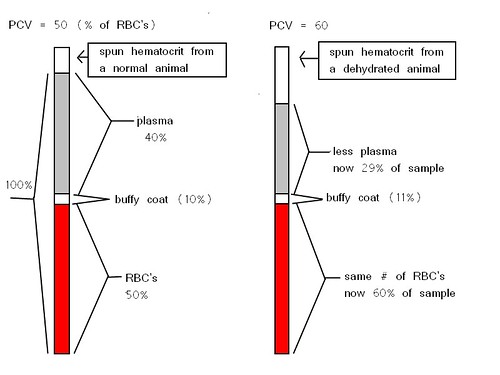PCV is the Packed Cell Volume which is also known as the hematocrit or HCT. Generally this is determined by taking a microhematocrit tube, filling it with blood collected in a tube, plugging one end with clay, and then spinning it at very high speeds in a centrifuge. After spinning, the blood components will separate in the tube with the red blood cells on the bottom, the white blood cells on top of that, and the plasma at the very top. The hematocrit tube is then placed on a reading card as shown below with the top of the clay lined up with the bottom line and the top of the plasma lined up with the top line. Finally, you find the number that matches up with the top of the red blood cells in the tube. So, in the picture below, if the red lines indicate changes of 10% on the table, the PCV of that hematocrit tube would be about 50%.
It is important to keep in mind that what this test really measures is the percent of the blood that is made up of red blood cells. The PCV is expected to go down in cases of anemia, but go up in cases of dehydration since there is less water (plasma) but the same number of RBC's. The drawing below may make the change with dehydration more clear. Click on it if you need to see a larger version of the image.

Decreased PCV:
A lower than normal PCV indicates anemia which has 3 main causes:
-Lack of RBC production: from bone marrow issues, nutrition problems, or kidney problems since the kidneys stimulate production via erythropoietin.
-Increased RBC destruction: due to intracellular parasites, immune disorders (IMHA), etc
-Loss: from external or internal bleeding.
Increased PCV:
-Dehydration: this is most common, but it is important to look at the albumin results of the Chemistry test and compare it to the PCV. If both are high the cause is likely dehydration.

No comments:
Post a Comment